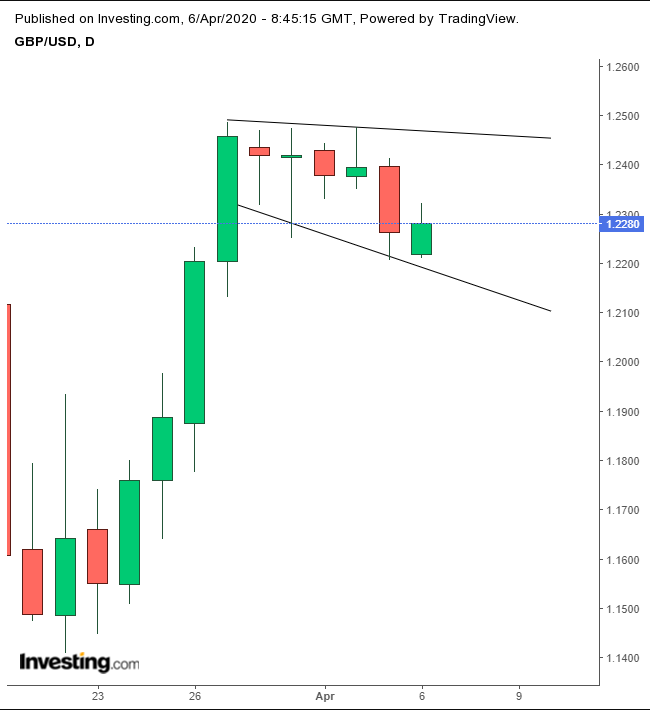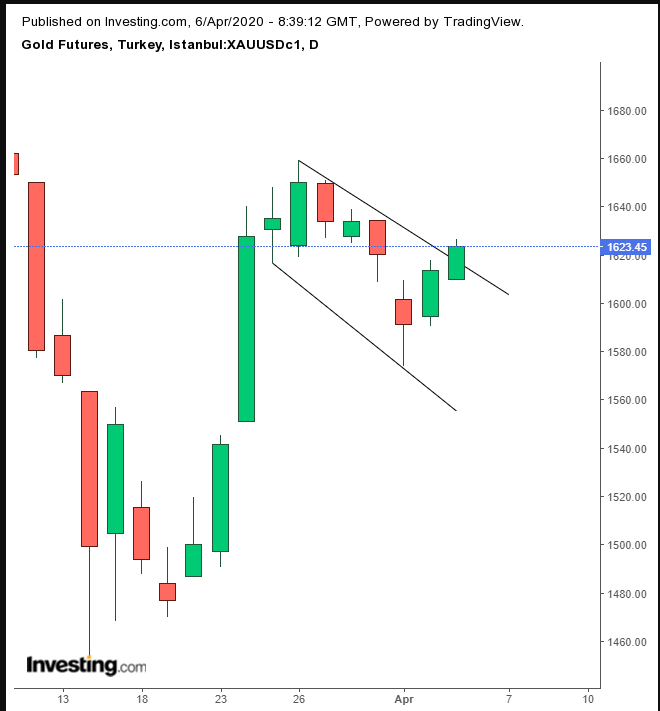- Italy, Spain, France and New York record easing virus-related death rates
- U.S. futures, global equities jump
- Trump warns of "very horrendous” phase in virus outbreak ahead
- Additional wild market swings expected as coronavirus uncertainty continues
- Australia's RBA is expected to leave interest rates at 0.25% on Tuesday.
- Crude oil inventories reported Wednesday; last week showed a surplus of 13.834M barrels.
- Thursday’s Initial Jobless Claims are anticipated to have jumped another 5,000K.
- The U.S. Core CPI release comes out on Friday.
- Futures on the S&P 500 rose 3.7%.
- The Stoxx Europe 600 index advanced 2.3%.
- The MSCI Asia Pacific Index jumped 2.4%.
- The Dollar Index rose 0.2%.
- The yen lost 0.5%, dropping to 109.06 per dollar.
- The euro bought $1.0810, up 0.1%.
- The pound slid 0.1% to $1.2263.
- The yield on 10-year Treasuries rose five basis points to 0.645%.
- West Texas crude dropped 2% to $27.78 a barrel.
- Gold futures rose 0.6% to $1,623.45.
Key Events
Contracts on the S&P, Dow Jones and NASDAQ surged this morning and global stocks popped as deaths from COVID-19 appear to have eased in some of the most infected areas around the world. Spain, France and Italy each reported lower mortality rates over the weekend, and New York, the current epicenter of the U.S. breakout, reported a fall in deaths on Sunday.
The dollar gave up an advance, and Treasurys sold off.
Global Financial Affairs
Futures for the S&P 500 catapulted higher on Monday, after deaths in New York dropped yesterday, for the first time, even as President Donald Trump said the nation is approaching a “very horrendous” phase in the virus outbreak. New York's Governor, Andrew Cuomo, warned that the lower NY number could just be a "blip."
Nevertheless, the STOXX 600 gapped up—though the pan-European index has since rolled back from session highs, at the time of writing—after reports that Italy’s victim count fell to the lowest in over two weeks; in Spain the number of fatalities fell for the third straight day and France’s rate declined to the lowest in five days.
Earlier this morning Asian stocks leaped. Australia’s ASX 200 outperformed (4.33%). Japan’s Nikkei 225 notched up a 4.24% gain, even though the Abe government is set to declare a state of emergency within the next few days. China's markets were closed for a holiday.
On Friday, U.S. indices all fell, trimming the preceding week’s gains, as the pandemic began to weigh heavily on the economy, via staggeringly bad U.S. jobs numbers. Thursday's Initial Claims were the worst ever recorded, followed by Friday's Nonfarm Payrolls, the worst in more than a decade. And the general consensus is that things will only get much worse before they even begin to get better.
As such, we expect to see more wild equity swings as a leaderless market attempts to gain a foothold, in one direction or the other. Remember, just a week earlier stocks jumped the most in 11 years.
Yields rose this morning as investors rotated out of safe havens and back into risk.

From a technical perspective, yields on the 10-year Treasury note are correcting after a fall, toward the top of a possible falling channel.
The dollar climbed for a fourth straight day.

Nevertheless, it gave up session highs. Technically, the greenback is travelling within a rising channel. Therefore, a continued ascent is more likely than a fall below the channel, as the mighty greenback provides a haven for investors amid what we expect is an ongoing stock market crash.
Sterling rebounded after UK Prime Minister Boris Johnson was hospitalized for further testing having been diagnosed with COVID-19 ten days ago.

Technically, the pound may be developing a bullish flag.
Gold rose for a second day.

The precious metal is attempting to break the top side of what may be a falling flag, bullish after the preceding jump.
Oil gave up some gains after producers Saudi Arabia and Russia postponed a crucial meeting to end their current price war, which has ravaged the market.

Technically, WTI's price is being pressured by resistance since early March and the downtrend line since Feb. 20.
